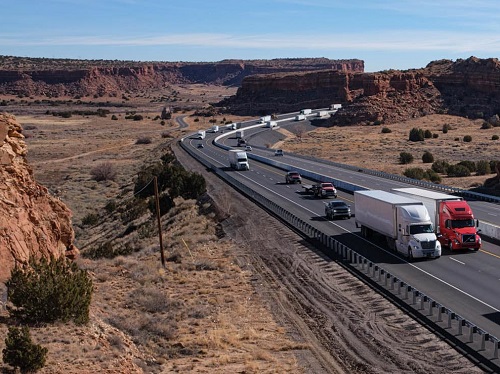A new report concludes that a lack of sufficient funding will make it difficult to adequately maintain and improve New Mexico’s existing transportation system.
[Above photo by NMDOT]
That report – compiled by TRIP, a Washington, D.C.-based research nonprofit, with the help pf the New Mexico Department of Transportation – included examination of regional pavement and bridge conditions, highway safety data, and cost breakdowns for the Albuquerque, Las Cruces, and Santa Fe urban areas as well as the statewide road system.

TRIP said its report found that 34 percent of major locally and state-maintained roads in New Mexico are in poor condition and another 22 percent are in mediocre condition, costing the state’s drivers a total of $1.3 billion each year in extra vehicle operating costs.
Furthermore, New Mexican roads and bridges that are deteriorated, congested, or lack some desirable safety features cost the state’s motorists a total of $3 billion annually – as much as $2,888 per driver in some areas – due to higher vehicle operating costs, traffic crashes, and congestion-related delays.
That includes $900 million in annual costs to motorists in New Mexico due to lost time and wasted fuel due to traffic congestion. Traffic congestion in the Albuquerque urban area alone results in the average driver losing 46 hours annually in traffic delays and wasting 20 gallons of fuel, costing the average Albuquerque driver $1,224 annually in lost time and wasted fuel.

Some $5.75 billion worth of improvement and reconstruction projects statewide identified by the New Mexico DOT could negate some of those losses, according to TRIP’s research, but those remain unfunded at this time. TRIP included a list of statewide unfunded projects in the report.
TRIP also found that the efficiency and condition of New Mexico’s transportation system, particularly its highways, is critical to the health of the state’s economy. Annually, $125 billion in goods are shipped to and from New Mexico, relying heavily on the state’s network of roads and bridges. The value of freight shipped to and from sites in New Mexico, in inflation-adjusted dollars, is expected to increase 59 percent by 2045, TRIP said.

However, TRIP noted that the level of highway investment across New Mexico is set to increase as a result of the $1.2 trillion Infrastructure Investment and Jobs Act or IIJA enacted in November 2021.
The IIJA will provide $3.2 billion in road, highway and bridge funding from 2022 to 2026, resulting in a 35 percent increase in federal funding in 2022.
“While additional federal funding from the IIJA will help New Mexico move forward with needed improvements to its transportation network that will make the state’s roads and bridges smoother, safer and more efficient while boosting the economy and creating jobs, the state will also need to provide an adequate and sustainable investment in its transportation network,” noted Dave Kearby, TRIP’s executive director, in a statement.
“Without adequate funding, New Mexico’s transportation system will become increasingly deteriorated and congested, hampering economic growth, safety and quality of life,” he added.
 States
States
Dina El-Tawansy Appointed Director of Caltrans
July 11, 2025 States
States

